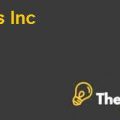
Hansson Private Label, Inc.: Evaluating an Investment in Expansion Case Solution
The project can be evaluated by different techniques in order to find out the financial viability of the project. The investment appraisal technique includes Internal Rate of Return (IRR) technique, Free Cash Flows (FCF) technique, Net Present Value (NPV) technique, Payback period technique etc. The Net Present Value is widely used in the financial evaluation of the projects, as in this technique the net cash inflows and outflows associated to the given project are discounted to the present value by a discounting factor usually WACC of the company.
Nonetheless, the net present value is the most appropriate method and evaluation of the projects through net present value is also a common practice of the industry as it gives the return in real terms by discounting the future cash flows at an appropriate discount rate. The management of the company should evaluate the project by using net present value and IRR and net present value of the project could be calculated with the help of free cash flows method.
Free cash flows related to the project could be calculated using assumptions in capital request form and by discounting these cash flows at an appropriate discount rate,the net present value of the project could be identified. If the project generates positive net present value and higher internal rate of return with respect to the company’s predefined return, then the project could be evaluated that whether it is worthwhile for the company or not.
The project could be evaluated by using historical data, past sales record, historical growth ratio regarding sales and could also be evaluated by using trend series regression analysis by using the past trend regarding personal care products.
The project of the Hansson Private Label for the expansion of the manufacturing facilities is evaluated on the basis of Net Present Value technique. In the evaluation, the total investment of the company is taken as $45,000 which is used for the facility expansion, manufacturing equipment and packaging equipment and the capital investment of $12,817. The depreciation charge of the $45,000 assets is reduced from the operating income of the project. The depreciation is done on the basis of straight line over the ten years life of the assets. This depreciation is then added back to give the cash flows of the project as the depreciation is non-cash item of the company.
On the other hand, the working capital investment is deducted from the net income after tax of the profit and by deducting working capital and adding depreciation charge and the release of the working capital at the end of the year, the net cash flows of the project are calculated. These net cash flows are then discounted by 9.38% of WACC. This gives the Net Present Value of the project as $34,646 with the terminal value of the project used and without the terminal value the Net Present Value of the project is negative, which is $16,853. This shows that the project is not feasible financially if the terminal value of the project in the NPV calculation is not used. However, the project will give return of $34,646 to the company if the terminal value of the cash flows is included in the NPV calculations.
2. Comparison of Financial information:
Revenue Growth:
The revenue growth in 2004 and 2005 was 8% and in 2007 the revenue growth was 7% with slight decrease. On the other hand, the revenue growth with the project will be 11% and 10% in 2009 and 2010; however the growth rate will be 2% in the last for years of the project.............
This is just a sample partial case solution. Please place the order on the website to order your own originally done case solution.













